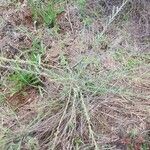Annual or perennial herb, 0.1-1.0 m; monoecious; erect, Sub-Erect or decumbent; much branched; glabrous. Leaves spirally arranged, chartaceous, linear, lanceolate, oblong, oblanceolate or obovate, acute, subacute, obtuse or rounded, base rounded-cuneate to attenuate. Stipules asymmetrically triangular-lanceolate, acuminate, Sub-Entire. Flowers present in almost all axils, distal axils with male or bisexual few-flowered fascicles, proximal with solitary, female flowers. Male flowers: sepals 6, biseriate; disc glands 6, minute, free, rounded, thin, flat, smooth; stamens 3. Female flowers: sepals 6, biseriate; disc glands 6, free, squarish, thin, flat, smooth; ovary sessile, rounded, 3-lobed, smooth; styles free, erect, shortly bifid. Fruit depressed, rounded or 3-lobed, smooth, segmentiform.
Leaf blades 1–5.5(7.5) × 0.2–1.5( 1.8) cm on the lead shoots, 0.5–3 × 0.05–0.9 cm on the lateral shoots, linear, lanceolate, oblong, oblanceolate or obovate, acute, subacute, obtuse or rounded, rounded-cuneate to attenuate at the base, chartaceous, smooth or slightly asperulous-papillose beneath and along the marginal nerve, grey-green above, somewhat glaucous beneath, sometimes edged with red; lateral nerves in 4–10 pairs, apically-directed, sometimes looped towards the apex, not prominent above, usually prominent beneath.
Female flowers: pedicels c. 2 mm long, not extending in fruit; sepals 6, biseriate, the outer accrescent to 1.8 × 1.2–1.3 mm, suborbicular-obovate, subacute, the inner sepals to 1.8 × 1–1.2 mm, somewhat spathulate, obtuse, dull green, often pinkish-or purplish-tinged, white-margined; disk glands 6, 0.3 mm across, free, squarish, thin, flat, smooth; ovary c. 1 mm in diameter, sessile, rounded-3-lobed, smooth; styles 3, 0.75 mm long, free, erect, shortly bifid.
Male flowers: pedicels 0.5–1 mm long; sepals 6, biseriate, the outer sepals 1.1–1.2 × 0.8 mm, obovate-spathulate, acute, the inner sepals 1.2 × 0.6 mm, oblong, rounded, yellowish-green; disk glands 6, minute, free, rounded, thin, flat, smooth; stamens 3, 1 mm long, filaments united into a short column, anthers 0.6 mm long, vertically held, apically free, thecae bilobed, longitudinally dehiscent, yellow.
Seeds 1.5 × 1.2 × 1.1 mm, segmentiform, dark brown, slightly shiny, with 12–15(22) rows of darker brown or blackish tubercles on the dorsal facet, and 11–12 concentric arcs of such tubercles on each ventral facet, the tubercles connected by a lattice of shallow lineate ridges.
Leaves spirally arranged; petioles (0.5)1(2) mm long; stipules 1–4 mm long, asymmetrically triangular-lanceolate, acutely acuminate, subentire, cordate-auriculate on one side at the base, whitish or pinkish-cream with a median brown stripe.
Perennial herb, up to 0.3 m high. Leaves with blade variously shaped, ± 30 x 7 mm, apex obtuse or rounded, margins flat, lateral veins prominent below. Flowers: perianth yellowish green; Nov.-Jun. Fruit sessile.
A herb or small shrub. It can grow for one or more years. It grows 10-60 cm high. Leaves are broadly sword shaped and 1-3 cm long by up to 1 cm wide. The fruit are round with 3 lobes. They are 3 mm across.
Perennial herb, up to 300 mm tall. Leaves linear-lanceolate or oblanceolate, up to 30 mm long and 7 mm broad, lateral nerves prominent below, appressed. Flowers yellowish green.
Flowers present in almost all axils, distal axils with male or bisexual few-flowered fascicles, proximal with solitary female flowers.
An erect, suberect or decumbent much-branched glabrous annual or perennial herb up to 1 m tall, monoecious.
Lead shoots and lateral shoots differing chiefly in leaf size, angular, often reddish-or brownish-tinged.
Fruit 2 × 3 mm, depressedrounded-3-lobed, smooth, somewhat shiny, olivaceous, often reddish-tinged.
A woody undershrub or herb, of variable habit
Glabrous or slightly asperulate
A weed in cultivated ground.










